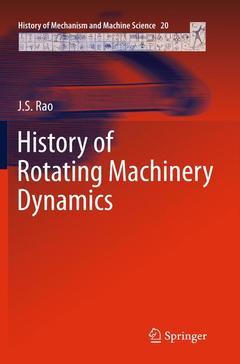History of Rotating Machinery Dynamics, 2011 History of Mechanism and Machine Science Series, Vol. 20
Auteur : Rao J.S.

Foreword; Preface; Acknowledgements; 1 Beginnings of the Wheel; References; 2 Science before the Medieval Period; References; 3 Water Wheels; References; 4 Wind Mills; References; 5 Renaissance and Scientific Revolution; References; 6 Renaissance Engineers; References; 7 Industrial Revolution; References; 8 Turbomachines; References 9 Fundamentals of Elasticity; References; 10 Energy Methods; 10.1 Euler—Lagrange Equations; 10.2 Lagrange Method; 10.3 Rayleigh's Energy Approach; 10.4 Ritz Method; 10.5 Lagrange Method for Vibration Problems; 10.6 Galerkin Method; 10.7 Hamilton's Principle; 10.8 Complementary Virtual Work; 10.9 Hellinger—Reissner Variational Principle; 10.10 Hu—Washizu Principle; 10.11Different Theories of Torsion of Rods; 10.11.1 Coulomb (1784) Elementary Theory , see Timoshenko and Goodier [42] for Circular Rods; 10.11.2St. Venant (1853) Theory, see Todhunter [43] and Timoshenko and Goodier [42] for Circular Rods; 10.11.3 Love's (1944) Theory; 10.11.4 Timoshenko (1945) — Gere's (1954) Theory; 10.11.5 Reissner (1952) and Lo—Goulard's (1955) Theory; 10.11.6 Barr's (1962) Theory; 10.11.7 Refined Theory by Rao (1974); References; 11 20th Century Graphical and Numerical Methods; 11.1 Stodola—Viannello (Rayleigh's Maximum Energy) Method in Graphical Form; 11.2 Stodola—Viannello Iterative Method in Tabular Form; 11.3 Dunkerley's Method; 11.4 Proof of the Dunkerley Formula by Blaess [1]; 11.5 Hahn's Proof Using Matrix Algebra [3]; 11.6 Holzer Method for Torsional Vibration; 11.7 The Myklestad Method [7,8]; 11.8 Prohl's Method [9]; References; 12 Matrix Methods; 12.1 Torsional Vibration Systems; 12.2 Far-Coupled Systems; 12.3 Gräffe's Method of Successive Approximations; 12.4 Matrix Iteration Method; 12.5 Method of Priebs [10]; 12.6 The Holzer Method (Close Coupled Systems) in Transfer Matrix Form; 12.7 Myklestad—Thomson (1949, 1953) — Prohl Methods in Transfer Matrix Form for Far-Coupled Systems; 12.8 A Brief Note on Computers and Evolution; References; 13 Finite Element Methods; 13.1 Beam Finite Element; 13.2 Tocher Triangular Plate Element (1962); 13.3 Shell Element; 13.4 Interface Damping through Finite Element Analysis; 13.5 Illustration of Turbomachine Blade Analysis using Commercial Codes; References; 14 Rotor Dynamics Methods; 14.1 De Laval Model; 14.2 Jeffcott Rotor Analysis; 14.3 Fluid Film Bearings; 14.4 Oil Film Instabilities; 14.5 Quality Factor; 14.6 Gyroscopic Effects; 14.7 Internal Friction, Hysteresis; 14.8 Shafts with Gravity and Variable Elasticity; 14.9 Misalignment; 14.10 Bowed Rotors; 14.11 Variable Inertia; 14.12 Seals and Instabilities; 14.13 Steam Whirl; 14.14 Cracked Shafts; References; 15 Transfer Matrix Methods; 15.1 Torsional Vibration due to Short Circuit of Generators; 15.2 Transfer Matrix Method for Lateral Vibrations of Rotors; 15.3 Twin Spool Rotor Analysis; References;16 Finite Element Methods for Rotor Dynamics; 16.1 Nelson's Beam Element; 16.2 Geared Rotors and Chaos; 16.3 Solid Rotors; 16.4 Two Spool Aircraft Engine [21]; 16.5 Cryogenic Pump Rotor Dynamic Analysis; References; 17 Bladed Disks; 17.1 Armstrong's Analysis for Tuned Systems; 17.2 Ewins' Analysis; 17.3 Mistuning Arrangement; 17.4 Damping; 17.5 Micro-Slip Damping (Fretting Fatigue); References; 18 Lifing; 18.1 High Cycle Fatigue (HCF) Life Estimation; 18.2 Low Cycle Fatigue (Strain Based Life Estimation); 18.3 Linear Elastic Fracture Mechanics; References; 19 Optimization; 19.1 Shape Optimization; 19.2 Weight Optimization; References; 20 Concluding Remarks; Index.
describes the evolution of industrial design practices of rotor dynamics since the times of the scientific revolution;
gives a critical overview;
points to future applications and developments.
Date de parution : 11-2014
Ouvrage de 358 p.
15.5x23.5 cm
Disponible chez l'éditeur (délai d'approvisionnement : 15 jours).
Prix indicatif 105,49 €
Ajouter au panierDate de parution : 02-2011
Ouvrage de 358 p.
15.5x23.5 cm
Disponible chez l'éditeur (délai d'approvisionnement : 15 jours).
Prix indicatif 105,49 €
Ajouter au panierThème de History of Rotating Machinery Dynamics :
Mots-clés :
finite elements; history; machinery dynamics; rotor dynamics; turbomachines



